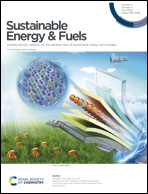Synthesis of plasmonic bismuth metal deposited InVO4 nanosheets for enhancing solar light-driven photocatalytic nitrogen fixation†
Abstract
In this study, metallic Bi deposited indium vanadate nanosheet (Bi/InVO4) photocatalysts were successfully fabricated by a two-step hydrothermal method. Multiple characterisation techniques were used to investigate the crystal structures, morphologies, and optical and electrical properties of Bi/InVO4. The photocatalytic performance of the as-prepared samples was evaluated via photocatalytic nitrogen fixation under mild conditions. The results show that 5% Bi/InVO4 exhibits the optimal photocatalytic performance, and the generation rate of NH3 is as high as 626 μmol g−1 h−1, which is 5.2 times higher than that of pure InVO4. The enhanced photocatalytic activity is caused by the surface plasmon resonance (SPR) endowed by metallic Bi which enhanced the light-harvesting and the effective separation and migration of charge carriers. Meanwhile, 5% Bi/InVO4 also demonstrates stability in multicycle N2 fixation. This study provides a new research strategy to synthesize high-performance catalysts for photocatalytic nitrogen fixation under mild conditions.



 Please wait while we load your content...
Please wait while we load your content...